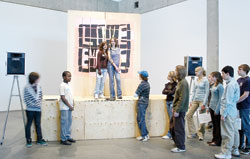Student’s Love Empire conquers the National Gallery

National Gallery visitors take up Mark Clintberg’s challenge to publicly declare their love as part of his installation piece Love Empire/L’empire de l’amour 2005. On display since the fall, it will come down on March 4.
© National Gallery of Canada
A Concordia student is now represented in the collection of the august National Gallery of Canada. Mark Clintberg, who is doing a Master’s in Art History, is the creator of Love Empire/L’empire de l’amour 2005, a large plywood installation on display in the landmark Ottawa building.
It takes the form of a rough wooden platform with a microphone and speakers. Gallery visitors are invited to take the stage and declare their love for someone or something.
Heather Anderson, an assistant curator, reports, “Over the months that Love Empire has been on display, declarations of love, renditions of pop songs, Christmas carols and various murmurings have resounded from its speakers.
“Groups ranging from school tours to teens and their friends, parents with kids as well as solitary visitors have responded to the casual aesthetic of the stage . . . Guards have reported a flurry of activity around the piece [and are] sometimes surprised by the sudden eruption of a voice.”
At the back of the platform, tucked under the stairs, is a little niche with a sleeping bag. “I think people like having permission to go in there,” Anderson said. “In the mornings, the sleeping bag and pillows look as though they’ve been tusselled around.”
In her research on the piece leading to the gallery’s decision to acquire it, she said, “There is a latent tension present in Love Empire: Declaring one’s love publicly transgresses the border between private expression and the larger public sphere.”
She also found interesting tension “in the work’s more sinister connotations that follow from the title and signage: Love Empire can be read as issuing an imperative. What might the command to “Love Empire” mean?”
While it’s unusual for the gallery to acquire work by a student, Anderson said the contemporary art collection necessarily includes works by relatively young artists, who are at the cutting edge of art practice.
Asked why artists like Clintberg forego conventional art forms like painting and sculpture for such an interactive, personal approach, she said, “I think they want more social engagement. Also, they often question the role of the museum.”
Last summer Clintberg was featured on Socket, a CBC Radio program focusing on young Canadian artists. He approached Montrealers on the street, inviting them to “declare their love for someone or something.”
Clintberg earned his BFA from the Alberta College of Art and Design in 2001 and was awarded a residency through the Walter Phillips Gallery at the Banff Centre for the Arts in 2005, where he created Love Empire for the Alberta Biennial. He has done curatorial work in Calgary and Miami’s Rubell Family Collection, and written for Canadian Art, The Art Newspaper and Arte al Dia International.
Clintberg told the Journal by email that in Montreal, he feels constantly challenged.
“The ground is always shifting in this city, whether because of switching languages abruptly in conversation or navigating shortcuts, so it means that there are fewer opportunities for a person to make assumptions about what is going on.”